CISTEME365 Seeks to Increase Experiences for Underrepresented Students in STEM—Trains Teachers to Start STEM Clubs
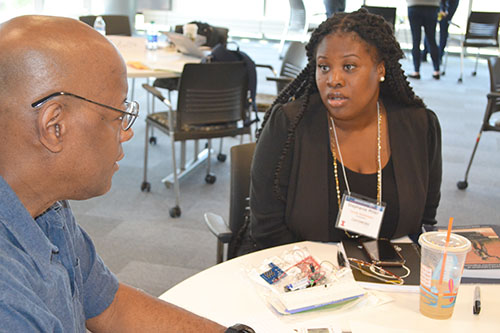
Donnell White, a science teacher, and Stephanie Miller, a counselor, both at John M. Smyth IB World School in Chicago, chat about their STEM club during a planning session.
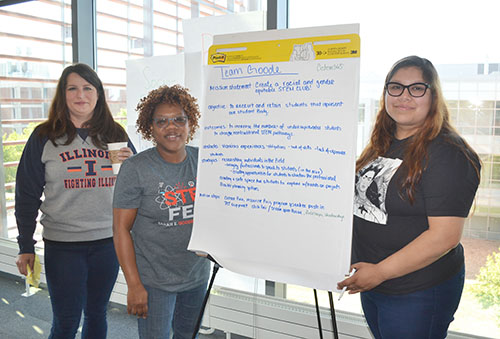
The team from Sarah E. Goode STEM Academy in Chicago by their Action Plan: Irica Baurer, an arts instructor; Anita Alicea, a STEM integration specialist; and Nancy Rodriguez, the post-secondary coach.
September 10, 2019
According to statistics, women and minorities are underrepresented in STEM (Science, Technology, Engineering, and Math). So, for years, Electrical and Computer Engineering (ECE) Professor Lynford Goddard has been exposing high school girls, including minorities, to electrical engineering via cutting-edge-yet-fun hands-on activities in his GLEE (Girls Learn Electrical Engineering) camp, which, to foster inclusion, included boys as well this past summer. Now, he hopes to increase the number of high schoolers he impacts annually from the 21 or so he’s been working with in GLEE, to significantly more than that—at least 1,000—through his 3-year NSF grant, Catalyzing Inclusive STEM Experiences All Year Round (CISTEME365). Plus, Goddard hopes to pass on not just some of his expertise, but the materials he’s developed over the years, to educators who will use what they learn to begin after-school STEM programs.
“The idea is that we want to be able to interact with students from across the state,” Goddard says. “We want to be able to transition the curriculum from GLEE to students throughout the state.”
So for two weeks this past summer, from July 22–August 3, 2019, five schools sent IDEA (Inclusion, Diversity, Equity, and Access) Teams to campus for the first CISTEME365 Institute. Although over the course of the grant, CISTEME365 will be working with 24 different partner schools, the 2019–2020 cohort has five schools: two local schools (Urbana High School and Mahomet-Seymour High School) and three Chicago Public Schools: John M. Smyth IB World School, and two high schools: the Chicago Vocational Career Academy and the Sarah E. Goode STEM Academy. While the program is targeting mostly high schools, middle schools will also be allowed. So, this year, there are four high schools and one elementary school, which is primarily going to focus on seventh and eighth graders.
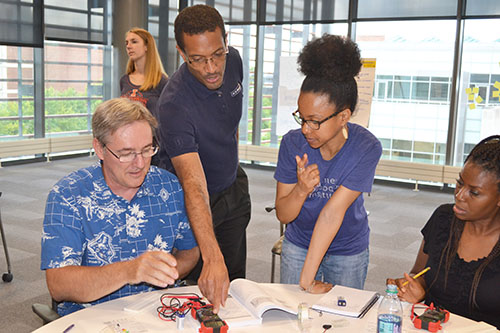
Lynford Goddard (third from the left) explains to Mahomet-Seymour science teacher, Terry Koker (left), how to complete the circut activity.
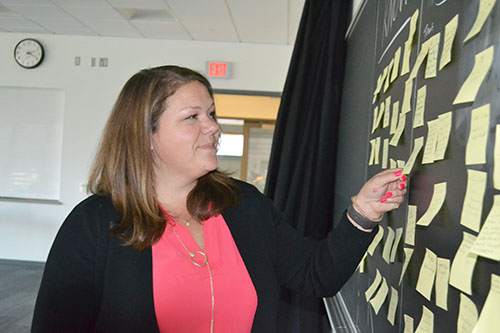
Megan Pollock studies the educator's "Aha moment" notes written as a result of her sessions on equity and inclusion the first week of the institute.
Each school’s team was comprised of three members: a teacher, a counselor, and a third person (another teacher or counselor, STEM specialist, vice principal, or even interested parent). The goal, according to Goddard, was to have a critical mass at each school. “Three people with different roles at the school,” he asserts, “so that the ideas of being a STEM advocate and being able to allow access and promote students into STEM careers and STEM majors is kind of universally held among the school staff, rather than just a single person.”
Lara Hebert, Grainger College of Engineering’s Outreach Coordinator and a CISTEME365 Co-PI, shares one reason school counselors were included on the schools’ IDEA Team. The idea is that when female, African-American, and Latino students go for counseling, the school counselors know that “In order for the students to get into a college major, they need to start at freshman year by taking this particular set of coursework.”
The counselors also need to believe these students can be successful in STEM. “They need that message that they can do it, and not the message that, ‘Oh, I think that this is for you instead!’—some of those things that sometimes happen in counseling situations.”
The Institute had two separate emphases. The first week was equity training taught by Meagan Pollock of the National Alliance for Partnerships in Equity (NAPE). The message of her week-long training was simple: reach and teach every student. According to Goddard, the collaboration with the Alliance came about because the program is NSF-funded and a scientifically-proven effective strategy. The group’s past work shows how effective the program is.
The second week, Goddard and his team, many of whom have taught the GLEE camp with him over the years, introduced the GLEE curriculum. “The idea is that we want the teachers and counselors to take that and go back to their schools and launch STEM clubs,” says Goddard.
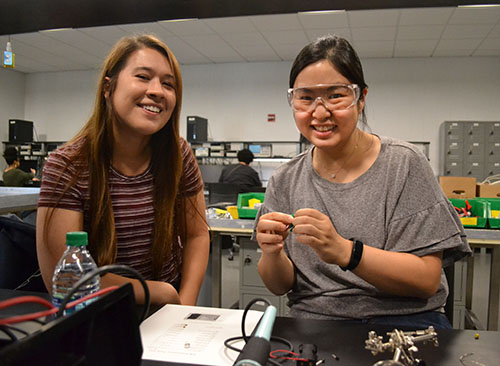
Goddard’s student, Kiran Murphy, gives Elizabeth Ohr, a science teacher at Urbana High School, some pointers while she solders her circuit.
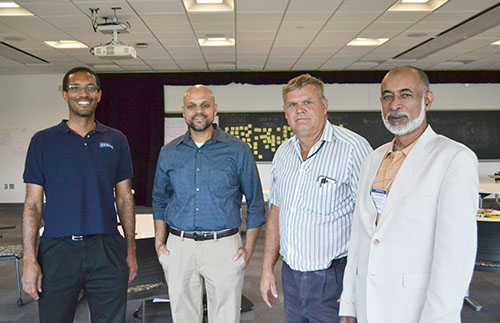
Left to right: Lynford Goddard, CISTEME365 PI; Imad Rahman and Paul Wever, two industry representatives; and Irfan Ahmad, Executive Director of the Center for Nanoscale Science and Technology, who served as MC of the Industry Panel.
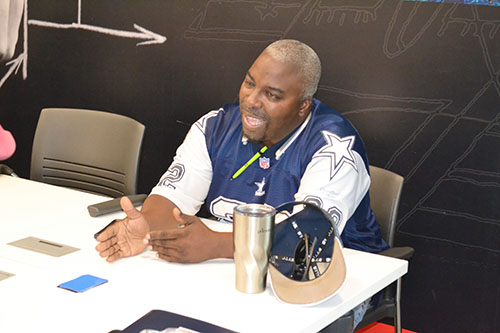
Lemond Peppers, student engagement advocate at Urbana High School, interacts with another educator during an activity.
Similar to GLEE, the week’s activities were a mix: brief trainings introducing electrical engineering topics were followed by related hands-on activities about breadboarding, motors, optics/imaging, how to design an experiment, algorithms, and how to solder safely. Plus, by the end of the week, each participant had completed several larger projects, building a circuit, LED calculator, and radio phone.
The educators also experienced tours, demonstrations, even a panel with members of industry: Imad Rahman of Henneman Engineering and Paul Wever of PWCE (Paul Wever Construction Equipment). Some tours/special activities dealt with imaging, bionanotechnology, antennas, and virtual reality. A special power and energy session taught by ECE faculty Subhonmesh Bose and Arijit Banerjee addressed a history of power systems, the physics behind electromechanical energy conversion, and research frontiers in power and energy. In addition, IDEA Teams also were given time to meet to work on Action Plans for their school’s club.
According to the participants, the Institute was invaluable in regards to starting their new clubs. For example, Donnell White, sixth grade math teacher and International Baccalaureate Coordinator for sixth through eighth grade at CPS’ John M. Smyth Elementary School says Lynford Goddard gave them lots of pointers on how to start their club. “He's given us a lot of insight, and the biggest thing he's given us is not only a sense of how to proceed, but this wonderful kit.”
Plus, Goddard offered to assist to whatever extent they might need him, including visiting the school. “They're giving us a lot of assistance,” White reports. “And that's what I like about this program. We're not just going out there alone. They're really arming us to be prepared.”
While White claims that, “Almost everything was fun,” one activity that particularly impressed him was that they actually made their own projectors. “It was very hands on, and it's what our students will be doing in this program through the projects that they'll be doing. But yeah, it was very hands on, creating your home pro prop—basically a projector.”
Lemond Peppers, a student engagement advocate for grades 9–12 at Urbana High School, shares his take on the institute: “This is just really an eye-opening experience. So I hope to take many of the resources back and, you know, sky's the limit.”
Anita Alicea, the STEM Integration Specialist at the Sarah E. Goode STEM Academy in Chicago, says the while her school already has a STEM club in place, that doesn't mean that every child is being exposed. She says their STEM club is an additional resource for students to have that opportunity to look and see, ‘Is this the right fit for me?’ Just because you have a club doesn't mean that that's the fit for every student." So regarding the new STEM club they’ll be beginning courtesy of CISTEME365, she remarks: “So again, this is just providing them with another resource and another opportunity to be exposed to STEM. That's what our whole goal is, to make sure that every student that walks through our door is exposed to STEM in one way or another.”
Like Sarah E. Goode, Mahomet-Seymour High already has a STEM club or two in place as well. However, Terry Koker, who teaches chemistry there, says the academic teams and clubs at Mahomet, which compete against other schools, generally only target the top 10%.
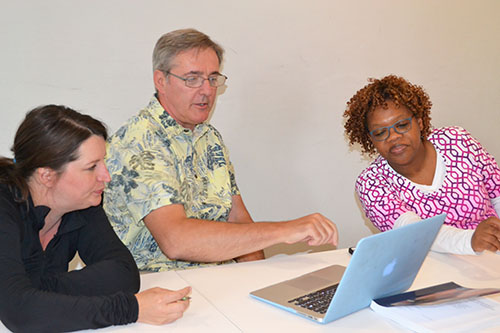
Irica Baurer, Goode arts instructor; Terry Koker, Mahomet-Seymour science teacher; and Anita Alicea, Goode STEM integration specialist, discuss how to go about an activity.
“But this is not about competition,” he claims. “So I think that opens it up then to anybody that wants to participate.”
In regard to the new STEM club they’ll be beginning, he’s hoping to draw some kids who are not in those highly competitive, team-based, activities—more the middle-level and even lower-level kid who just likes science and is interested, but doesn't feel like he or she can compete on the math team. “Cause we'll be drawing them in with fun activities,” he says. “They need to start somewhere and begin to build, to be able to see themselves, once they get four years in at high school, as being able to handle a STEM career or STEM education at Illinois or somewhere.”
While IDEA Team members received training on how to foster inclusion plus do many of the hands-on activities that will be provided, Goddard claims the goal is for the STEM clubs to be run by students. “We want these clubs to be kind of student organized, and student run, and student motivated,” he explains. “We don't want it to be just, ‘Here's an extra class that you can take!’ We want it to be student-driven activities.” Goddard says he’s in a wait-and-see mode regarding whether the students will take charge. “It's not clear that that's going to be easy to implement,” he admits. “But we'll see.”
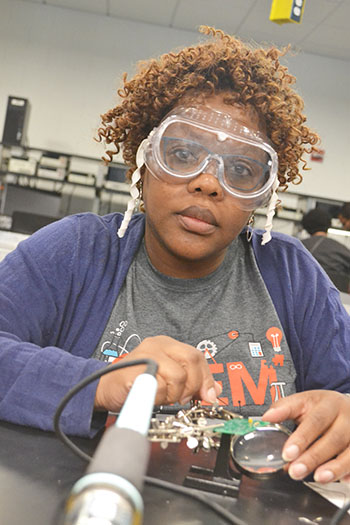
Anita Alicea, a STEM integration specialist at Sarah E. Goode STEM Academy, soldering a circuit.
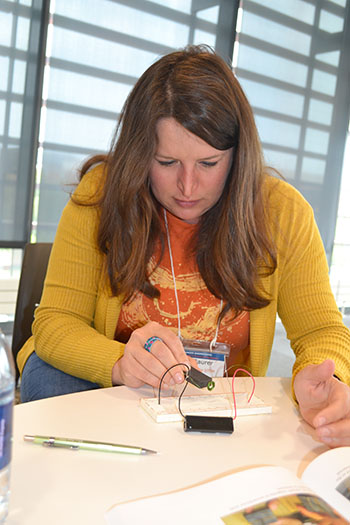
Irica Baurer, an arts instructor at Sarah E. Goode STEM Academy works on the breadboard hands-on activity.
Another aspect of the grant was to promote networking and foster community not just among IDEA Team members, but the 2019–20 cohort. According to Hebert, during the Institute, “they're building really strong relationships, all sort of focused in the same area. So they have that relationship building that they've already been doing.” Besides the summer institute, CISTEME365 will also encourage networking and community throughout this next academic year, but beyond. For instance, once a month, “They will be able to hop on a conference call with one another and be able to share their progress, share their questions, share insights, share new things that they've tried, and really be able to learn from one another throughout the year,” Hebert adds.
While direct services to this cohort lasts for only one year, CISTEME365 intends to continue to support the network of schools. “So having that online space,” Hebert says, “and having those opportunities for them to continue networking and continue growing. We want to help support them as they're thinking about how to round up continued funding and growing supporters. And then we are building relationships with them and seeing what they need.” She suggests how Grainger College of Engineering itself could continue to support the clubs: “Faculty as they're writing Career grants and they're looking for something to do, we can say, ‘You can develop some curriculum that can then go into the STEM clubs and be used by the STEM clubs.”
Along with implementing the Institute and paying educators ’ stipends, the grant is also providing resources to schools. The fledgling clubs will receive equipment, supplies, materials, textbooks, and project ideas students can explore.
Plus, as an additional incentive to pique students’ interest in STEM, a third grant component will nominate students from participating schools who will receive scholarships to attend WYSE (Worldwide Youth in Science and Engineering) camps at Illinois other than GLEE, since they will have already experienced many of the activities.
Hebert shares that the free scholarships are to encourage underserved students to pursue STEM by “giving them also some of the opportunities that students who are in more high-resource schools have opportunities to do—so those out-of-school learning opportunities, those enrichment pieces that the students are going to have, those experiences of summer camps,” she indicates, with the goal that “those little pieces are going to really keep them motivated to continue to pursue STEM all the way into college.”
One thing Hebert finds rewarding about CISTEME365 is networking with the schools in hopes of continuing to work with them. “So I'd also love to connect to these schools with our undergraduate students as mentors,” she says.
However, the most rewarding thing about CISTEME365 for Hebert is hopefully impacting students in the future. “It's students finding their way into STEM that often change their minds along the path because they haven't seen themselves or they haven't seen the possibility of themselves…I really hope to see them here at summer camps; I hope to see them enrolled here as freshman and knowing me already and coming to say hello.”
Author/Photographer: Elizabeth Innes, Communications Specialist, I-STEM Education Initiative
More: CISTEME365, Electrical and Computer Engineering, Teacher Professional Development, 2019
For additional istem articles on CISTEME365, please see:
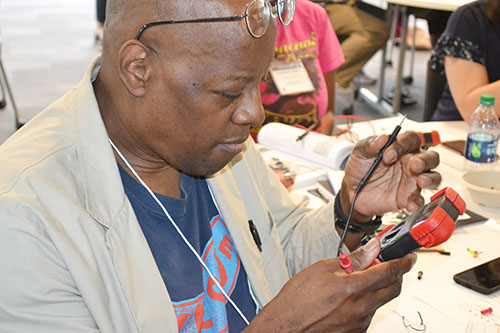
Donnell White, a science teacher at John M. Smyth IB World School, prepares to test the circuit he's building.
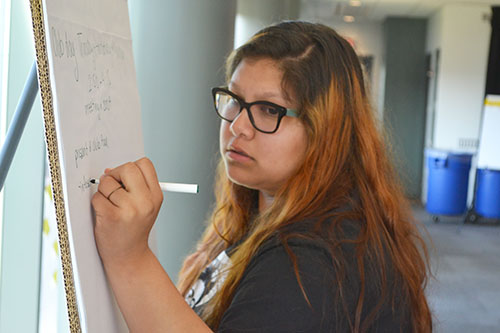
Nancy Rodriguez, the Sarah E. Goode STEM Academy's post-secondary coach, adds some ideas to her team's Action Plan.
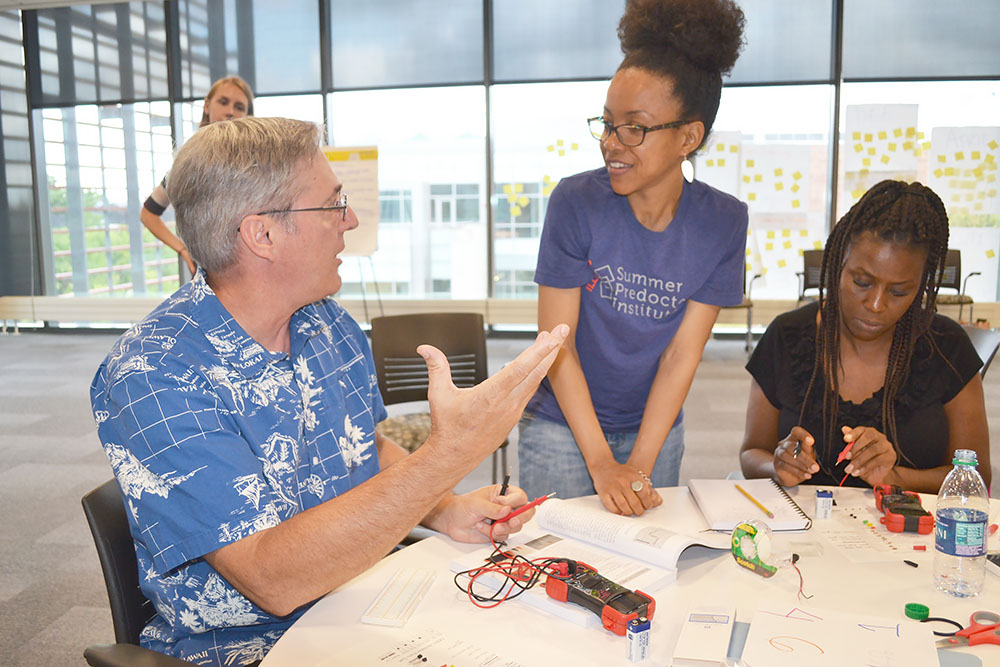
Mahomet-Seymour High chemistry teacher Terry Koker chats with Goddard's PhD student and long-time GLEE camp assistant, Lonna Edwards, about the circuit he's building.













.jpg)
















